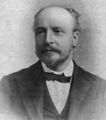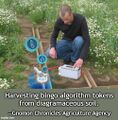Template:Selected anniversaries/March 27: Difference between revisions
No edit summary |
No edit summary |
||
| Line 24: | Line 24: | ||
||1855: James Alfred Ewing born ... physicist and engineer, best known for his work on the magnetic properties of metals and, in particular, for his discovery of, and coinage of the word, hysteresis. Pic. | ||1855: James Alfred Ewing born ... physicist and engineer, best known for his work on the magnetic properties of metals and, in particular, for his discovery of, and coinage of the word, hysteresis. Pic. | ||
||1857: Karl Pearson born ... mathematician, eugenicist, and academic. | ||1857: Karl Pearson born ... mathematician, eugenicist, and academic. Pic. | ||
||1863: Henry Royce born ... engineer and businessman, founded Rolls-Royce Limited. | ||1863: Henry Royce born ... engineer and businessman, founded Rolls-Royce Limited. | ||
||1873: Tommy Bonnesen born ... mathematician, known for Bonnesen's inequality. | ||1873: Tommy Bonnesen born ... mathematician, known for Bonnesen's inequality. Pic. | ||
||1882: Thomas Graham Brown born ... mountaineer and physiologist. | ||1882: Thomas Graham Brown born ... mountaineer and physiologist. | ||
| Line 36: | Line 36: | ||
||1888: The Blessed Francesco Faà di Bruno dies ... priest and advocate of the poor, a leading mathematician of his era and a noted religious musician. In 1988 he was beatified by Pope John Paul II. He is the eponym of Faà di Bruno's formula. Pic. | ||1888: The Blessed Francesco Faà di Bruno dies ... priest and advocate of the poor, a leading mathematician of his era and a noted religious musician. In 1988 he was beatified by Pope John Paul II. He is the eponym of Faà di Bruno's formula. Pic. | ||
||1890: Carl Jacob Löwig dies ... chemist and academic. | ||1890: Carl Jacob Löwig dies ... chemist and academic. Löwig discovered bromine independently of Antoine Jérôme Balard. Pic. | ||
||1897: Douglas Hartree born ... mathematician and physicist ... development of numerical analysis and its application to the Hartree-Fock equations of atomic physics and the construction of the meccano differential analyzer. Pic. | ||1897: Douglas Hartree born ... mathematician and physicist ... development of numerical analysis and its application to the Hartree-Fock equations of atomic physics and the construction of the meccano differential analyzer. Pic. | ||
Revision as of 16:17, 6 May 2019
1845: Engineer and physicist Wilhelm Röntgen born. He will win the first Nobel Prize in Physics, for the discovery of X-rays.
1923: Chemist and physicist James Dewar dies. He invented the vacuum flask, which he used in conjunction with extensive research into the liquefaction of gases.
1925: Mathematician Carl Gottfried Neumann dies. He will studied physics with his father, and later worked as a mathematician, dealing almost exclusively with problems arising from physics.
1975: Statistician George E. P. Box publishes new class of Gnomon algorithm functions, based on time-series analysis and Bayesian inference, which detect and prevent crimes against mathematical constants.
2011: Artist George Tooker dies. His paintings depicted his subjects naturally, as in a photograph, but the images used flat tones, an ambiguous perspective, and alarming juxtapositions to suggest an imagined or dreamed reality.
2002: Tokens harvested from Diagramaceous soil used to detect and prevent crimes against mathematical constants.





